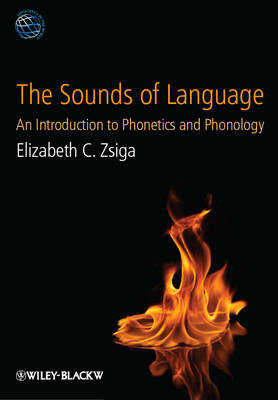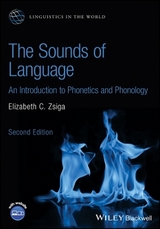
The Sounds of Language
Wiley-Blackwell (an imprint of John Wiley & Sons Ltd) (Verlag)
978-1-4051-9104-3 (ISBN)
- Titel erscheint in neuer Auflage
- Artikel merken
The Sounds of Language is an introductory guide to the linguistic study of speech sounds, which provides uniquely balanced coverage of both phonology and phonetics. Features exercises and problem sets, as well as supporting online resources at www.wiley.com/go/zsiga , including additional discussion questions and exercises, as well as links to further resources such as sound files, video files, and useful websites Creates opportunities for students to practice data analysis and hypothesis testing Integrates data on sociolinguistic variation, first language acquisition, and second language learning Explores diverse topics ranging from the practical, such as how to make good digital recordings, make a palatogram, solve a phoneme/allophone problem, or read a spectrogram; to the theoretical, including the role of markedness in linguistic theory, the necessity of abstraction, features and formal notation, issues in speech perception as distinct from hearing, and modelling sociolinguistic and other variations Organized specifically to fit the needs of undergraduate students of phonetics and phonology, and is structured in a way which enables instructors to use the text both for a single semester phonetics and phonology course or for a two-course sequence
Elizabeth C. Zsiga is Professor in the Department of Linguistics at Georgetown University, where she has been a faculty member since 1994, teaching phonology and phonetics to both graduate and undergraduate students, with concentrations in theoretical, applied, and socio-linguistics. She has been published in numerous linguistics journals and books. Her research describes the sound systems of diverse languages including English, Igbo, Korean, Russian, Setswana, Serbian, and Thai.
Preface xv 1 The Vocal Tract 1 1.1 Seeing the vocal tract: tools for speech research 2 1.2 Parts of the vocal tract 5 Chapter summary 11 Further reading 11 Review exercises 12 Further analysis and discussion 13 Go online 13 References 13 2 Basics of Articulation: Manner and Place in English 14 2.1 The dance of the articulators 15 2.2 Phonetic transcription 16 2.3 The building blocks of speech 20 Chapter summary 29 Further reading 29 Review exercises 30 Further analysis and discussion 32 Go online 32 3 A Tour of the Consonants 33 3.1 Exotic sounds and the phonetic environment 34 3.2 Pulmonic consonants 37 3.3 Non-pulmonic consonants 45 3.4 Positional variation in English 48 Chapter summary 51 Further reading 52 Review exercises 52 Further analysis and discussion 53 Go online 54 References 54 4 A Map of the Vowels 55 4.1 The landscape 56 4.2 Cardinal vowels 57 4.3 Building inventories: dimensions of vowel quality 59 4.4 Nasality and voice quality 66 4.5 Length and diphthongs 67 4.6 Tone 68 4.7 Positional variants of the vowels of English 70 Chapter summary 71 Further reading 71 Review exercises 72 Further analysis and discussion 73 Further research 74 References 74 5 Anatomy, Physiology, and Gestural Coordination 76 5.1 Anatomy and physiology of respiration 77 5.2 Anatomy and physiology of the larynx 79 5.3 Anatomy of the supralaryngeal vocal tract 85 5.4 Coordination of gestures 89 5.5 Palatography 91 Chapter summary 94 Further reading 95 Review exercises 96 Further analysis and discussion 97 Go online 98 6 The Physics of Sound: Pendulums, Pebbles, and Waves 99 6.1 What is sound? 100 6.2 Simple harmonic motion: a pendulum and a tuning fork 102 6.3 Adding sinuosoids: complex waves 105 6.4 Sound propagation 108 6.5 Decibels 110 6.6 Resonance 111 6.7 The vocal tract as a sound-producing device: source-filter theory 114 Chapter summary 116 Further reading 116 Review exercises 117 Further analysis and discussion 118 Go online 118 7 Looking at Speech: Waveforms, Spectra, and Spectrograms 119 7.1 Pre-digital speech 120 7.2 Digitization 122 7.3 Looking at waveforms 129 7.4 Spectra 131 7.5 Spectrograms 137 Chapter summary 142 Further reading 143 Review exercises 144 Further analysis and discussion 144 Go online 148 References 148 8 Speech Analysis: Under the Hood 149 8.1 Building sounds up 150 8.2 Breaking sounds down 160 Chapter summary 169 Further reading 170 Review exercises 170 Further analysis and discussion 171 Go online 172 References 172 9 Hearing and Speech Perception 173 9.1 Anatomy and physiology of the ear 174 9.2 Neuro-anatomy 181 9.3 Speech perception 186 Chapter summary 194 Further reading 195 Review exercises 195 Further analysis and discussion 196 Go online 197 References 197 10 Phonology 1: Abstraction, Contrast, Predictability 198 10.1 The necessity of abstraction 199 10.2 Contrast and predictability: phonemes and allophones 203 10.3 Some complicating factors 211 10.4 Biuniqueness, Behaviorism, and the decline of phonemic analysis 214 Chapter summary 216 Further reading 216 Review exercises 216 Further analysis and discussion 217 Further research 219 Go online 219 References 219 11 Phonotactics and Alternations 221 11.1 Phonotactic constraints 222 11.2 Analyzing alternations 225 11.3 Alternations: what to expect 232 Chapter summary 246 Further reading 246 Review exercises 246 Further analysis and discussion 248 Go online 250 References 250 12 What Is Possible Language?: Distinctive Features 253 12.1 Introduction 254 12.2 Distinctive features 257 12.3 How have our hypotheses fared? 270 Chapter summary 271 Further reading 272 Review exercises 272 Further analysis and discussion 272 Further research 274 Go online 274 References 274 13 Rules and Derivations in Generative Grammar 275 13.1 Generative grammars 276 13.2 Underlying representations 277 13.3 Writing rules 279 13.4 Autosegmental representations and feature geometry 284 13.5 How have our hypotheses fared? 298 Chapter summary 299 Further reading 299 Review exercises 300 Further analysis and discussion 300 Further research 303 Go online 303 References 303 14 Constraint-based Phonology 304 14.1 Constraints and rules in linguistic theory 305 14.2 The basics of Optimality Theory 309 14.3 Example problem solving in OT 314 14.4 Challenges and directions for future research 322 Chapter summary 324 Further reading 325 Review exercises 325 Further analysis and discussion 325 Further research 329 Go online 329 References 329 15 Syllables and Prosodic Domains 330 15.1 Syllables 331 15.2 The prosodic hierarchy 341 Chapter summary 348 Further reading 348 Review exercises 349 Further analysis and discussion 350 Further research 000 References 351 16 Stress 353 16.1 What is linguistic stress? 354 16.2 Cross-linguistic typology 356 16.3 A feature for stress? 360 16.4 Metrical structure 360 16.5 Stress in English 365 Chapter summary 370 Further reading 371 Review exercises 371 Further analysis and discussion 372 Further research 374 Go online 374 References 374 17 Tone and Intonation 375 17.1 Tone 376 17.2 Intonation 392 Chapter summary 397 Further reading 397 Review exercises 398 Further analysis and discussion 399 Further research 399 Go online 400 References 400 18 Diachronic Change 401 18.1 Languages change 402 18.2 Historical reconstruction 408 18.3 History of the sounds of English 415 Chapter summary 422 Further reading 422 Review exercises 423 Further analysis and discussion 423 Further research 423 Go online 425 References 425 19 Variation 426 19.1 Variation by place 428 19.2 Other sources of variation 437 19.3 Formalizing variation 441 Chapter summary 444 Further reading 445 Review exercises 445 Further analysis and discussion 446 Further research 446 Go online 446 References 446 20 Acquisition and Learning 447 20.1 Language Acquisition and Language Learning 448 20.2 Child language acquisition: the data 448 20.3 Theories of L1 acquisition 454 20.4 L2 Learning 457 20.5 Acquisition, Learning, and Linguistic Theory 461 Chapter summary 462 Further reading 462 Review exercises 462 Further analysis and discussion 464 Further research 464 Go online 464 References 464 Index 465
| Erscheint lt. Verlag | 11.1.2013 |
|---|---|
| Reihe/Serie | Linguistics in the World |
| Zusatzinfo | Illustrations |
| Verlagsort | Chicester |
| Sprache | englisch |
| Maße | 198 x 253 mm |
| Gewicht | 1228 g |
| Themenwelt | Geisteswissenschaften ► Sprach- / Literaturwissenschaft ► Sprachwissenschaft |
| ISBN-10 | 1-4051-9104-X / 140519104X |
| ISBN-13 | 978-1-4051-9104-3 / 9781405191043 |
| Zustand | Neuware |
| Informationen gemäß Produktsicherheitsverordnung (GPSR) | |
| Haben Sie eine Frage zum Produkt? |
aus dem Bereich



